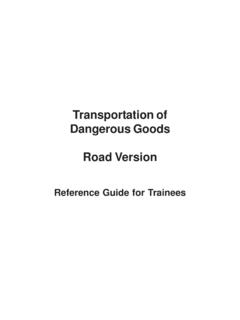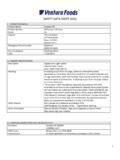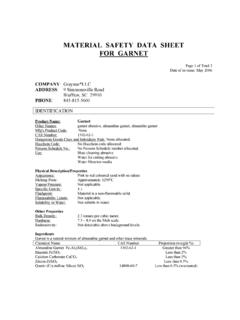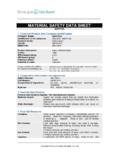Transcription of Material Safety Data Sheet - Varouh Oil, Inc.
1 Material Safety data Sheet SECTION 1 PRODUCT AND COMPANY IDENTIFICATION Spindle Oils Product Use: Industrial Oil Synonyms: Spin 3, Spin 10, Spin 15, Spin 22 Company Identification : Varouh Oil, Inc 970 Griswold Rd. Elyria, Ohio 44035 United States of America Transportation Emergency Response CHEMTREC: (800) 424-9300 or (703) 527-3887 Health Emergency Varouh Oil, Inc. Emergency Information 440 324 5025 Product Information email : Product Information: 440 324 5025 MSDS Requests: 440 324 5025 or SECTION 2 COMPOSITION/ INFORMATION ON INGREDIENTS COMPONENTS CAS NUMBER AMOUNT Highly refined mineral oil (C15 - C50) Mixture 80 - 90 %weight Distillates, straight run (gas oil, light) 64741-44-2 10 - 20 %weight SECTION 3 HAZARDS IDENTIFICATION ** EMERGENCY OVERVIEW - MAY CAUSE LUNG DAMAGE IF SWALLOWED ** IMMEDIATE HEALTH EFFECTS Eye: Not expected to cause prolonged or significant eye irritation.
2 Skin: Contact with the skin is not expected to cause prolonged or significant irritation. Not expected to be harmful to internal organs if absorbed through the skin. High-Pressure Equipment Information: Accidental high-velocity injection under the skin of materials of this type may result in serious injury. Seek medical attention at once should an accident like this occur. The initial wound at the injection site may not appear to be serious at first; but, if left untreated, could result in disfigurement or amputation of the affected part. Ingestion: Because of its low viscosity, this Material can directly enter the lungs, if swallowed, or if subsequently vomited. Once in the lungs it is very difficult to remove and can cause severe injury or death.
3 Inhalation: Not expected to be harmful if inhaled. Contains a petroleum-based mineral oil. May cause respiratory irritation or other pulmonary effects following prolonged or repeated inhalation of oil mist at airborne levels above the recommended mineral oil mist exposure limit. Symptoms of respiratory irritation may include coughing and difficulty breathing. SECTION 4 FIRST AID MEASURES Eye: No specific first aid measures are required. As a precaution, remove contact lenses, if worn, and flush eyes with water. Skin: No specific first aid measures are required. As a precaution, remove clothing and shoes if contaminated. To remove the Material from skin, use soap and water. Discard contaminated clothing and shoes or thoroughly clean before reuse.
4 Ingestion: If swallowed, get immediate medical attention. Do not induce vomiting. Never give anything by mouth to an unconscious person. Inhalation: No specific first aid measures are required. If exposed to excessive levels of Material in the air, move the exposed person to fresh air. Get medical attention if coughing or respiratory discomfort occurs. Note to Physicians: Ingestion of this product or subsequent vomiting may result in aspiration of light hydrocarbon liquid, which may cause pneumonitis. In an accident involving high-pressure equipment, this product may be injected under the skin. Such an accident may result in a small, sometimes bloodless, puncture wound. However, because of its driving force, Material injected into a fingertip can be deposited into the palm of the hand.
5 Within 24 hours, there is usually a great deal of swelling, discoloration, and intense throbbing pain. Immediate treatment at a surgical emergency center is recommended. SECTION 5 FIRE FIGHTING MEASURES Leaks/ruptures in high pressure system using materials of this type can create a fire hazard when in the vicinity of ignition sources (eg. open flame, pilot lights, sparks, or electric arcs). FIRE CLASSIFICATION: OSHA Classification (29 CFR ): Not classified by OSHA as flammable or combustible. NFPA RATINGS: Health: 0 Flammability: 1 Reactivity: 0 FLAMMABLE PROPERTIES: Flashpoint: (Cleveland Open Cup) 140 C (284 F) (Min) Autoignition: No data Available Flammability (Explosive) Limits (% by volume in air): Lower: Not Applicable Upper: Not Applicable EXTINGUISHING MEDIA: Use water fog, foam, dry chemical or carbon dioxide (CO2) to extinguish flames.
6 PROTECTION OF FIRE FIGHTERS: Fire Fighting Instructions: This Material will burn although it is not easily ignited. For fires involving this Material , do not enter any enclosed or confined fire space without proper protective equipment, including self-contained breathing apparatus. Combustion Products: Highly dependent on combustion conditions. A complex mixture of airborne solids, liquids, and gases including carbon monoxide, carbon dioxide, and unidentified organic compounds will be evolved when this Material undergoes combustion. SECTION 6 ACCIDENTAL RELEASE MEASURES Protective Measures: Eliminate all sources of ignition in vicinity of spilled Material . Spill Management: Stop the source of the release if you can do it without risk.
7 Contain release to prevent further contamination of soil, surface water or groundwater. Clean up spill as soon as possible, observing precautions in Exposure Controls/Personal Protection. Use appropriate techniques such as applying non-combustible absorbent materials or pumping. Where feasible and appropriate, remove contaminated soil. Place contaminated materials in disposable containers and dispose of in a manner consistent with applicable regulations. Reporting: Report spills to local authorities and/or the Coast Guard's National Response Center at (800) 424-8802 as appropriate or required. SECTION 7 HANDLING AND STORAGE Precautionary Measures: DO NOT USE IN HIGH PRESSURE SYSTEMS in the vicinity of flames, sparks and hot surfaces.
8 Use only in well ventilated areas. Keep container closed. Do not taste or swallow. General Handling Information: Avoid contaminating soil or releasing this Material into sewage and drainage systems and bodies of water. Static Hazard: Electrostatic charge may accumulate and create a hazardous condition when handling this Material . To minimize this hazard, bonding and grounding may be necessary but may not, by themselves, be sufficient. Review all operations which have the potential of generating and accumulating an electrostatic charge and/or a flammable atmosphere (including tank and container filling, splash filling, tank cleaning, sampling, gauging, switch loading, filtering, mixing, agitation, and vacuum truck operations) and use appropriate mitigating procedures.
9 For more information, refer to OSHA Standard 29 CFR , 'Flammable and Combustible Liquids', National Fire Protection Association (NFPA 77, 'Recommended Practice on Static Electricity', and/or the American Petroleum Institute (API) Recommended Practice 2003, 'Protection Against Ignitions Arising Out of Static, Lightning, and Stray Currents'. Container Warnings: Container is not designed to contain pressure. Do not use pressure to empty container or it may rupture with explosive force. Empty containers retain product residue (solid, liquid, and/or vapor) and can be dangerous. Do not pressurize, cut, weld, braze, solder, drill, grind, or expose such containers to heat, flame, sparks, static electricity, or other sources of ignition.)
10 They may explode and cause injury or death. Empty containers should be completely drained, properly closed, and promptly returned to a drum reconditioner or disposed of properly. SECTION 8 EXPOSURE CONTROLS/PERSONAL PROTECTION GENERAL CONSIDERATIONS: Consider the potential hazards of this Material (see Section 3), applicable exposure limits, job activities, and other substances in the work place when designing engineering controls and selecting personal protective equipment. If engineering controls or work practices are not adequate to prevent exposure to harmful levels of this Material , the personal protective equipment listed below is recommended. The user should read and understand all instructions and limitations supplied with the equipment since protection is usually provided for a limited time or under certain circumstances.









